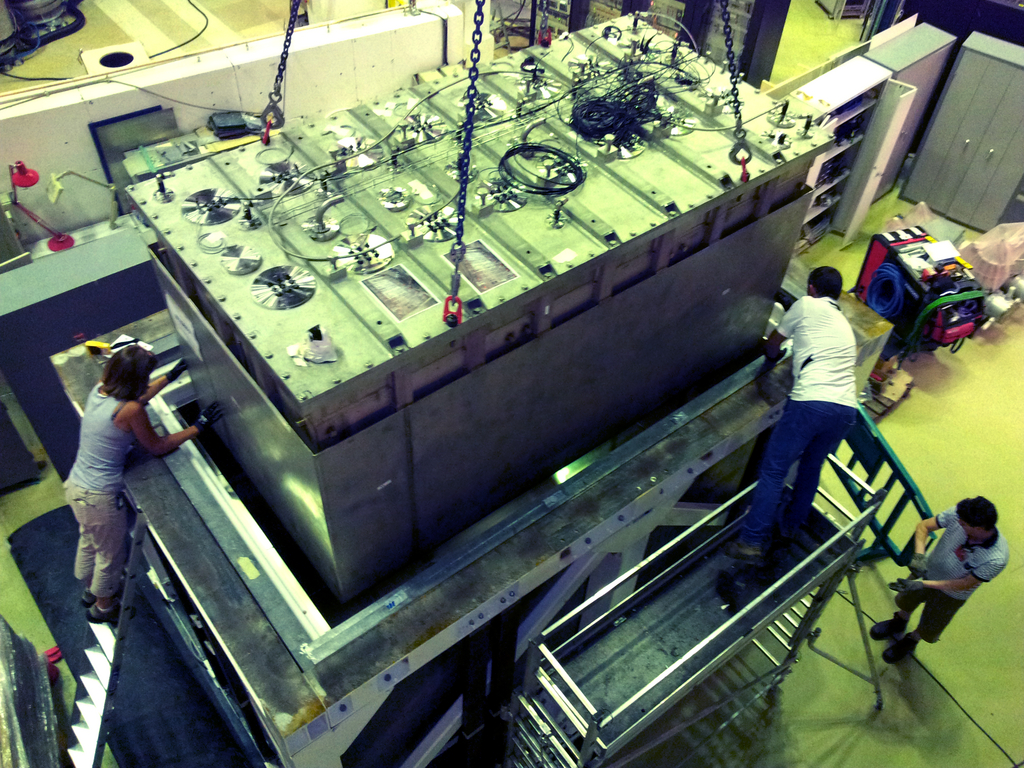Stereo scientists refute the existence of sterile neutrinos
 (png - 470 Ki)
(png - 470 Ki)Artist views of the STEREO experiment. By Loris Scola - CEA
Grenoble, 11 January 2023 | Stereo, the collaboration between the CEA, CNRS, the Université Grenoble-Alpes (UGA), the Université Savoie Mont Blanc (USMB), the Institut Laue-Langevin (ILL), and the Max Planck Institut für Kernphysik (MPIK), has found no proof that the sterile neutrino exists after six years of experimentation. Their conclusion will impact numerous branches of physics, with their study to be published on 11 January in Nature.
The physicists involved in the Stereo collaboration are unequivocal: the sterile neutrino is not responsible for the anomaly in neutrinos emitted by nuclear reactors.
The Stereo team, which includes scientists from the CEA, CNRS, UGA, USMB, ILL and MPIK, has been relentless in its search for this particle for the past six years, without having found anything to prove its existence during the neutrino oscillation experiment using the Stereo detector designed to study neutrinos produced in the ILL research reactor.
This experiment brings years of questioning to an end. The existence of the sterile neutrino is a potential natural extension of the standard model, developed by particle physicists in the second half of the 20th century. This particle would provide an explanation to some still poorly understood physical phenomena, such as dark matter. Physicists believed they they had seen traces of the sterile neutrino in several past experiments in nuclear reactors when they realised that fewer neutrinos had been produced during fission than predicted by their models.
To test the assumption whether sterile neutrinos exist and determine their properties, researchers in the Stereo team decided to use a very strong source of neutrinos, those produced in the high-flux reactor at the ILL in Grenoble. A series of six identical detectors were installed only ten metres from the reactor core to collect data, with the team already benefiting from a wealth of knowledge accumulated over several decades of experiments. Protected from any unwanted signals in the surrounding environment, these detectors were ideally positioned to detect the signature of sterile neutrinos with unparalleled sensitivity: much more than a simple deficit in standard neutrinos, a conversion in their energy distribution was expected to be found.
“This deficit in reactor neutrinos exacerbated other anomalies observed in previous experiments. The sterile neutrino was considered a potential breakthrough in particle physics and we believed it was within our reach; we were wholly invested in this adventure,” explained David Lhuillier, a CEA physicist and representative of the collaboration.
Over a period of 4 years between 2017 and 2020, followed by another 2 years of data analysis, a total of 107,558 neutrinos were observed without a single trace of a sterile neutrino.
Researchers had to find another way to explain this deficit in the number of neutrinos emitted during the radioactive decay of fission products. The accuracy of the Stereo measurements is so precise that the team began to look in another direction: it seems it is not the experiments that detect the neutrinos that would be biased, but rather the nuclear data used to predict radioactive decay.
The energy distribution of neutrinos resulting from the fission of uranium-235 measured by Stereo has therefore become the reference data, which is driving a vast programme to reassess the beta emissions of fission products described in the nuclear databases. For instance, this programme will allow us to more accurately understand the phenomena coming into play during the shutdown of either a current or future nuclear reactor. The results of the Stereo collaboration also provide a solid foundation on which to base the next series of experiments in reactor environments, whether for reactor monitoring by measuring the neutrinos emitted, for studying the neutrino mass hierarchy, or for further testing the standard model at low-energy.
Photo galery of the STEREO setup
 (jpg - 815 Ki)
(jpg - 815 Ki)Inside of the STEREO target, before installation of the walls separating the 6 cells. The reflective walls are meant to collect efficiently the light produced by the interaction of the neutrinos with the liquid scintillator.
Top view of the inner detector being mounted. One can see the 6 central cells defining the target volume. The first and last cells have the same geometry but they are not used as target cells. Their role is to mitigate edge effects so that all central cells have the same environment.
Inner detector volume almost fully equipped. Only one of the target cell is missing its photomultipliers, allowing the see the reflective walls.
Top view the detector cells with all photomultipliers and associated electronics (red disks) installed.
 (jpg - 1.07 Mi)
(jpg - 1.07 Mi)The STEREO inner detector hermetically closed and inserted inside the shielding structure.
The full [detector + shielding] assembly is covered with black sheets of neutron absorber to reduce the external background. On this picture the 93 tonns of STEREO are lifted with air cushions so that the structure can be pushed underneath the water channel, visible in the background (with the green balcony).
Previously published in the ILL scientific news
March 2018 - Stereo puts pressure on a 4th neutrino
March 2019 - STEREO is moving up a gear
Stereo is a joint French-German experiment developed and carried out by a team of scientists from the CEA-IRFU in Saclay, the ILL Institute in Grenoble, the CNRS-USMB LAPP laboratory in Annecy, the CNRS-UGA LPSC laboratory in Grenoble, and the MPIK Institute in Heidelberg, Germany.
Re: STEREO neutrino spectrum of 235U fission rejects sterile neutrino hypothesis. Nature613, 257–261 (2023). https://doi.org/10.1038/s41586-022-05568-2
Nature's News & Views :Nuclear reaction rules out sterile-neutrino hypothesis
ILL contact: Torsten Soldner
STEREO collaboration:www.stereo-experiment.org


